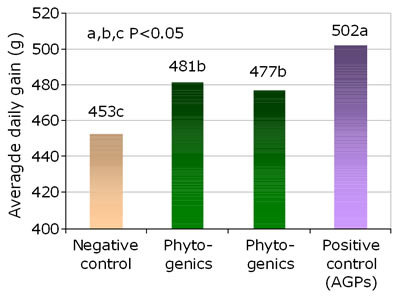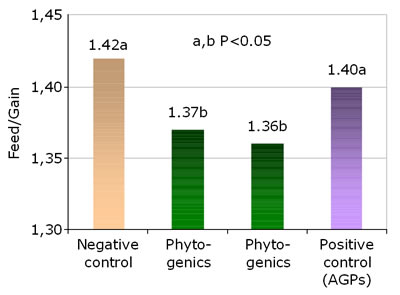Phytogenic Performance Enhancers in Piglets - Benefits of a Proven Approach
The swine production sector is facing several challenges. The need for optimal feed efficiency, in terms of feed conversion ratios, becomes even more evident in present times of rising prices for feed ingredients. Growing concern about Antibiotic Growth Promoters (AGPs) in animal nutrition has created efforts to use different alternative growth-promoting agents in swine nutrition. Clearly, phytogenics represent a new and exciting group of feed additives, originating from herbs, spices or other plants. An improvement in feed conversion ratio (FCR) has been observed in recent trials conducted in the United States, Europe and South Africa.
Phytogenics affect feed conversion
Optimizing FCR is crucial for efficiency in swine production. Recent results from Kansas State University (USA) have shown significantly improved FCR when pigs were fed phytogenics. The trial was carried out with 192 3-week old piglets (Sulabo et al., 2007) which were assigned to four treatment groups: Group 1 was fed a negative control diet without growth promoters. Groups 2 and 3 received the negative control diet plus phytogenics. Group 4 was offered a positive control diet containing AGPs (140 g/t neomycin sulfate and 140 g/t oxytetracycline HCl). Growth performance was significantly improved over the negative control group when phytogenics or AGPs were added to the feed. In terms of average daily gain, the pigs fed phytogenics were intermediate between the negative control and the AGPs (Figure 1). Feed conversion, however, was best in the groups receiving phytogenics (Figure 2). The phytogenic feed additive under investigation contained a defined blend of essential oils from anise, citrus and oregano, as well as plant extracts.

Figure 1. Effects of phytogenics on average daily gain (Kansas State University)

Figure 2. Effects of phytogenics on feed efficiency (Kansas State University)
The results from Kansas State University confirmed positive observations obtained in previous experiments. A trial conducted in Denmark by Danske Slagterier also showed an increase in performance when the feed was supplemented with phytogenics (Table 1). The feed was pelleted at a minimum temperature of 81 °C.
Table 1. Piglet performance in response to phytogenics (Danske Slagterier)
| Negative Control | Phytogenics | Difference (%) | |
| No. of pens | 24 |
24 |
|
| No. of piglets | 192 |
192 |
|
| Daily weight gain (g) | 422 |
444 |
+ 5.2 |
| Feed intake (FUp1) | 0.84 |
0.85 |
+1.2 |
| Feed conversion ratio | 2.01 |
1.92 |
- 4.5 |
| Danish Production Value | 55.5 |
61.2 |
+ 10.3 |
1 One FUp corresponds to 7.72 MJ net energy (P<0.1)
Not only daily gain and FCR were improved by 5.2 and 4.5%, respectively. Also the Danish Production Value was increased by 10.3% through supplementation of the feed with phytogenics. The Danish Production Value represents an indicator of productivity and is calculated as follows: (kg gain × DKK/kg gain)–(no. of analyzed FUp × DKK/FUp), with figures being based on average local prices. Finally, recent observations from a field trial conducted in South Africa (Carletonville area, North West Province) have shown substantial benefits of phytogenics in weaned pigs. The trial was carried out on a commercial farm and lasted 37 days. Pigs in group A (control) were fed a basal diet containing Tylan (1 kg/t) and zinc oxide (4 kg/t), whereas pigs in group B were fed the basal diet supplemented with phytogenics (Biomin® P.E.P.). As shown in Table 2, considerable improvements in daily weight gain were seen when the pigs were fed phytogenics. Moreover, pigs in group B were more uniform in size at the end of the trial.
Table 2. Fiel trial with weaned pigs (data from South Africa)
| Group A (Control) | Group B (Phytogenics) | |
| No. of piglets | 46 |
34 |
| Weaning age | 30 |
30 |
| Average weaning weight (kg) | 8.47 |
8.76 |
| Average weight (kg) at end of trial | 22.93 |
26.53 |
| Average daily weight gain (g) | 391 |
480 |
The experience from Europe shows that the ban of AGPs does definitely not leave an insuperable hurdle for swine producers. One reason is that management practices can still be optimized in order to improve hygienic conditions and to minimize the impact of environmental stressors. Furthermore, effective alternative feed additives are available, such as demonstrated in the above trial results.
Phytogenics differ!
Phytogenic feed additives are usually available in the form of dried and ground material, extracts or essential oils. They contain a large number of biological activities, therefore having the potential to beneficially affect gut health and performance. However, phytogenic feed additives usually vary seriously in their chemical composition. Hence, there are large differences in efficacy between phytogenic products in the market. A big challenge for swine producers is to find the suitable product formulation out of an increasing number of phytogenic feed additives which are available. Only formulations which are based on profound scientific research can be expected to deliver sustainably an improvement in growth performance. Although scientific literature about phytogenic agents is multiplying rapidly, there is still a remarkable lack of information regarding the mode of action of phytogenics and the answer to the question: How do phytogenics work in the animal?
Phytogenics support digestion?
Many herbs and spices are known for their flavoring properties, thus having the potential to stimulate voluntary feed intake – an effect often observed in lactating sows (Miller et al., 2003). In the production of piglets, weaning is an extremely critical point, since the transition from sow's milk to solid feed is a challenge to the young piglets' digestive system, which can easily cause diarrhoea coinciding with dramatic drops in performance. Well-selected phytogenics may stabilize gut health and support digestion during this critical period. An extensive study, carried out at the University of Natural Resources and Applied Life Sciences, Vienna (Kroismayr et al., 2005), was directed to discover the mode of action of phytogenics, using the above-mentioned phytogenic additive as model substance in growing pigs. The researchers discovered significant effects caused by the phytogenic additive, with respect to gastrointestinal, as well as blood and immune parameters. Moreover, these effects were associated with improved growth performance.
Conclusion and outlook
Well-investigated phytogenics are an efficient tool to support animal health and growth performance. Since they do not pose any risk regarding antibiotic resistance or residues in animal products such as meat, eggs or milk, phytogenics are expected to gain high consumer's acceptance and are generally regarded as safe alternatives to AGPs. Particular attention, however, has to be paid on the composition of formulations which are available in the market. Only a well-balanced and scientifically developed combination of active ingredients with different properties can be expected to function synergistically in order to bring about the desired benefits for the producer.
For more information please visit www.biomin.net













 BIOMIN Holding GmbH
BIOMIN Holding GmbH +43 2782 803 0
+43 2782 803 0






